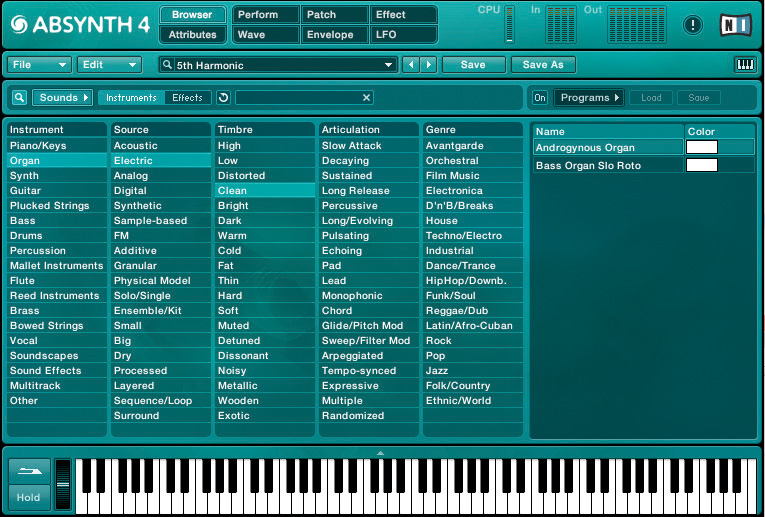MusicRadar Verdict
A somewhat fiddly (though improved) interface prevents Absynth from scoring top marks, but it remains an absolutely awesome synth.
Pros
- +
Vastly improved file management. Stunning sound. More user-friendly. Slicker interface. Kore integration.
Cons
- -
Can still be awkward to program. Expensive upgrade.
MusicRadar's got your back



For the benefit of newcomers, we should say that Absynth - now at version 4 - offers a powerful and versatile soft synth concept, relying on conventionally modelled and sampled waveforms to produce its sounds.
Its power lies largely in the way you can manipulate, design and combine waveforms and then control them during playback using uniquely powerful envelopes.
Throw in some fine filters, effects and real-time controls and it's not hard to see why Absynth is many a sound designer's weapon of choice. But all of this power and flexibility has come at a cost - Absynth has traditionally been fiddly to program and its presets difficult to navigate.
However, NI managed to add both better usability and tasty new features in version 3, so the hope is that they've done the same with this update.
New and improved
Absynth 4 operates either standalone or as a plug-in, but whichever way you use it, loading it up for the first time presents you with a completely overhauled interface. It's still Absynth, but the GUI is larger and a little clearer.
You'll notice the first big improvement when you look at the Browser window, which is now a far more sophisticated beast than before. Thanks to the implementation of NI's Kore technology, presets and effects can now be selected from a browsable interface that enables you to narrow down your choices by choosing characteristics (Instrument, Source, Timbre, Articulation and Genre). You can even assign a personalised rating to a patch.
Want all the hottest music and gear news, reviews, deals, features and more, direct to your inbox? Sign up here.
This type of browser is cropping up everywhere these days (we've seen similar systems recently in Cubase 4 and Arturia's Analog Factory) and is something we welcome.
Elsewhere, Absynth now has a much-expanded effects section. At first glance, the effects screen seems to be one of the more needlessly confusing, but once you get to grips with it, you realise that it offers some very powerful processing and real-time control options.
Having said that, Absynth still fails where so many other synths have before it - it doesn't have a master 'disable FX' button - invaluable when you're browsing presets to place in an already busy track.
Another addition (in retrospect, it seems staggering that it wasn't there before) is a master ADSR envelope for quickly adjusting Absynth's complex layered patches to your requirements.
Also new are 16 assignable macro controls, each of which enables you to group and tweak a selection of parameters simultaneously. These are freely assignable and setting them up is easy - perfect when you want to get busy with some expressive, real-time twiddling on the spur of the moment.
There are many other improvements, too, ranging from a new oscillator module and wave morphing (waveforms can be blended in one oscillator) to an envelope step mode that makes envelope tweaking feel like additive synth programming.
Evolution not revolution
With today's music software, much of the effort that used to go into developing new features now seems to be aimed at making the ones we've already got work as well as we always wanted them to, and this is certainly the case with Absynth 4.
If you ever struggled with version 3's preset management system, for example, you'll think the browser system alone is worth the upgrade price.
That said, some version 3 users may feel there's not quite enough here to warrant the upgrade fee this time. If you're perfectly happy with what you've got, we wouldn't argue against sticking with it and saving yourself a bit of cash.
In the final reckoning, though, Absynth 4 goes down as an extremely powerful synth for the expert sound designer, an exceptional preset bank for the casual synth user, and an increasingly approachable training synth for novice programmers.
MusicRadar is the number 1 website for music makers of all kinds, be they guitarists, drummers, keyboard players, djs or producers...
GEAR: We help musicians find the best gear with top-ranking gear round-ups and high- quality, authoritative reviews by a wide team of highly experienced experts.
TIPS: We also provide tuition, from bite-sized tips to advanced work-outs and guidance from recognised musicians and stars.
STARS: We talk to musicians and stars about their creative processes, and the nuts and bolts of their gear and technique. We give fans an insight into the actual craft of music making that no other music website can.
